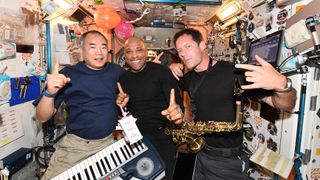How do you clean a space station? Astronaut Thomas Pesquet shares orbital spring cleaning tips
Astronauts have to keep the space station super clean to keep microbes under control.

International Space Station astronauts don't have time to sleep in on Saturday mornings. They're far too busy sticking to their strict cleaning schedule, as Saturday is their big "cleaning day" of the week when surfaces have to be sanitised and dust removed.
In a call with journalists on Friday (April 30), European Space Agency (ESA) astronaut Thomas Pesquet, who arrived at the orbital outpost aboard Dragon Crew Endeavour on April 24, shared insights into what a space station cleaning routine really looks like.
The inhabitants of the International Space Station are kept as safe as possible from the ongoing COVID-19 pandemic, as strict pre-flight quarantine and other safety measures are in place for crew members as well as newly-delivered equipment, Pesquet said during the conference. However, keeping potentially nefarious microorganisms in check is still an important part of safe living in space, and improper hygiene habits have no place on board.
"We have to disinfect all the surfaces we touch every week," Pesquet said. "We also have a lot of measures on the space station that are similar to those you can find in hospitals or at airports that are designed to prevent the propagation of bacteria."
While microbe populations, like the microbiomes in our guts, are necessary for human health, the growth of harmful microorganisms in a closed environment such as the International Space Station, where air is constantly recycled, could create the risk of serious health problems. Therefore, the space station currently hosts several experiments that test various antibacterial and antiviral materials designed to prevent the growth of microorganisms that come into contact with them, Pesquet mentioned.
Space agencies are studying advanced materials that could make future space travel safer. Such materials could do the same job on Earth, protecting door knobs, elevator buttons and other objects that humans frequently touch.
Related: There Are Bacteria and Fungi All Over the Space Station, and Now We Know What They Are
Get the Space.com Newsletter
Breaking space news, the latest updates on rocket launches, skywatching events and more!
Earlier this year, a Boeing-led experiment began at the space station testing a new type of antimicrobial surface coating that could help to prevent the spread of microbes, including the SARS-CoV-2 virus, in airplanes. The experiment requires astronauts to regularly touch two sets of objects including an aeroplane seat buckle, a piece of seatbelt fabric and a tray table. Only one set of objects is treated with the coating. As astronauts touch the objects, they transmit microbes that naturally occur on human skin. After the samples return to Earth, Boeing will analyse how effectively the coating stopped the spread of the microorganisms.
The European Space Agency (ESA), previously ran a similar set of experiments to test the ability of five types of surface materials to repel microbes. The experiment, called Matiss (Microbial Aerosol Tethering on Innovative Surfaces in the international Space Station), returned to Earth earlier this year after more than twelve months in space.
Previous studies have shown that many types of microorganisms thrive on the space station, with some doing even better in the microgravity environment than on Earth. A NASA study published in 2020 also found that the station's microbiome changes as crews rotate, which makes sense as each astronaut brings their own unique set of microbes with them, which then colonize the station’s interior.
Speaking about the weekly cleaning routine on the space station during her 2014 Futura mission, European astronaut Samantha Cristoforetti said in a blog post that astronauts use disinfectant wipes to sanitise handrails, handheld microphones, computers and anything else they touch to minimise their bacterial trail. She further added that "the toughest modules to clean are certainly Node 3, where we have the toilet and the exercise equipment, and Node 1, where we eat." The astronauts take turns cleaning the messiest modules, she wrote.
Astronauts also have to regularly vacuum clean ventilation grids, which can "get pretty dirty, because all the little debris that floats in the cabin eventually gets taken by the airflow to a return grid," Cristoforetti wrote. A blocked ventilation grid could impair the station’s carbon dioxide scrubbing mechanisms, making the air inside unfit for breathing, Cristoferetti added.
Follow Tereza Pultarova on Twitter @TerezaPultarova. Follow us on Twitter @Spacedotcom and on Facebook.
Join our Space Forums to keep talking space on the latest missions, night sky and more! And if you have a news tip, correction or comment, let us know at: community@space.com.

Tereza is a London-based science and technology journalist, aspiring fiction writer and amateur gymnast. Originally from Prague, the Czech Republic, she spent the first seven years of her career working as a reporter, script-writer and presenter for various TV programmes of the Czech Public Service Television. She later took a career break to pursue further education and added a Master's in Science from the International Space University, France, to her Bachelor's in Journalism and Master's in Cultural Anthropology from Prague's Charles University. She worked as a reporter at the Engineering and Technology magazine, freelanced for a range of publications including Live Science, Space.com, Professional Engineering, Via Satellite and Space News and served as a maternity cover science editor at the European Space Agency.
